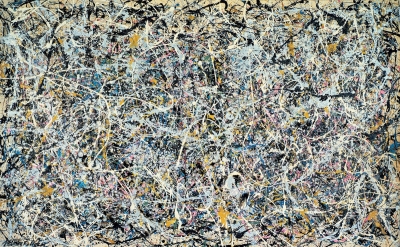
A post-World War II movement that developed in New York in the mid 1940s. abstract Expressionism was all about filling the canvas with vibrant brushstrokes that exuded intense emotions. The most famous painters of this movement are Jackson Pollock, Willem de Kooning and Franz Kitne. The movement inspired artists to create monumentally-sized works that represented the inner psyche, breaking away from traditional forms of art.
The name Abstract Expressionism came to be accepted by the group of artists since they all expressed intense emotions and universal themes but were also inspired by Surrealist art. In the beginning, the artists looked at primitive and ancient cultures to inspire them, and hence, their early works had pictographic elements. Later on, the movement showcased different techniques of abstraction developed along the way. In 1947, Jackson Pollock developed a radical new technique, wherein he dripped and poured paint on a canvas. The paintings were large in scale and shocked many viewers, who were also exposed to Kooing’s new style of using figurative elements in abstract style.
The first generation of abstract expressionists grew between the mid-1940s and 1950s and changed the focus of the art world from Paris to New York. And, in a time of uncertainty and doubt, this movement emerged as the first authentically American avant garde art movement.
Examples
Excavation: This painting, made in 1950 by Willem de Kooning, showcases his innovative brushstroke techniques and organisation of space. It has a great mix of tension between abstraction and figurative elements. Over six-and-a-half feet tall and eight feet wide, this painting is the biggest he ever made.
The Moon Woman: This Jackson Pollock painting was during the days he shifted from Regionalism to Abstract Expressionism. There is a moon woman, a regionalist theme, strong and challenging. But there is also more because the painting doesn’t merely show everything clearly but abstracts it, and adds fiery colours to elevate its intensity. This is the perfect juxtaposition of two art movements.
Symphony No. 1, The Transcendental: Richard Pousette-Dart painted this monumental piece thick with dark colours. The work is a mix of Cubism, Surrealism, Abstract Expressionism and mural painting. The title allows us to believe that Pousette-Dart was trying to create an elevated, aesthetic experience, like an orchestral symphony.
Wow Facts
- Due to the chaos and tumultuous times in Europe, many artists migrated to New York, and suddenly, New York became the centre of modern art. And Abstract Expressionism, deemed an American art movement, created art that was large, individualistic and romantic.
- In the 1940s, Jackson Pollock’s approach to art changed the potential of contemporary art and redefined it. His technique of dripping paint on canvas to express intense emotions made him realize that the journey of making art was as important as the art itself.
Picture Credit : Google
